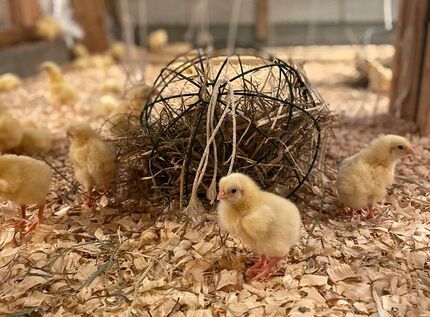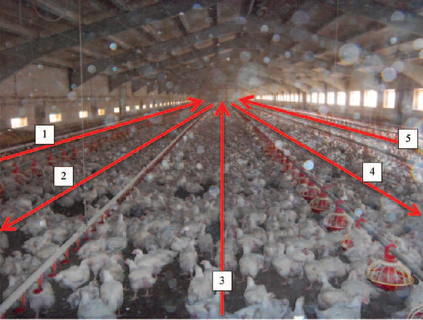 Leonie Jacobs - Commercial housing conditions may contribute to chronic negative stress in broiler chickens, reducing their animal welfare. The aim of this study was to examine the impact of environmental complexity and stocking density on the levels of immunoglobulin-A (IgA) in fast-growing broiler chickens. IgA might provide insights in the chronic stress experienced. IgA levels decrease when the body is subjected to physiological or physical stress. On the other hand, these levels increase when individuals have positive experiences. This study revealed that broiler chickens housed in complex environments exhibited higher concentrations of plasma IgA, suggesting a lower level of chronic stress compared to those in simpler environments. Moreover, birds raised in low-density environments displayed increased concentrations of secretory IgA, indicating reduced chronic stress compared to birds in high-density environments. These results demonstrate that the concentrations of plasma and secretory IgA in broiler chickens are influenced by their housing conditions. It is worth noting that these measures effectively differentiate levels of chronic stress when statistical power is high. However, further research is required to validate these outcomes under similar and diverse conditions before these measures can be widely adopted for assessing chronic stress in broiler chickens. You can read the study here Campbell, A.M., Anderson, M.G., Jacobs, L. Measuring Chronic Stress in Broiler Chickens: Effects of Environmental Complexity and Stocking Density on Immunoglobulin-A Levels. Animals 2023, 13, 2058. https://doi.org/10.3390/ani13132058 Categories
1 Comment
5/10/2021 0 Comments Transect method reflects environmental inputs and production outcomes on broiler farms 5 transects in a broiler house (Marchewka et al. 2013) 5 transects in a broiler house (Marchewka et al. 2013) by Shawna Weimer - Assessing the welfare of individual broiler chickens in large flocks is difficult. The transect method offers a reliable way to perform a walk-through inspection of broiler flock welfare. Transect sampling is intended for practical use by farmers, flock supervisors, veterinarians, and animal welfare auditors to obtain a quick but quantitative snapshot of the current welfare status of a flock. The transect method is performed by a human that slowly walks along successive transects, or rows between the feeder and drinker lines (1-5 in the image), and records the number of birds observed to have the following welfare problems: walking difficulties (lame, immobile), illness (sick, terminally ill, dead), skin wounds (on the head, back, and tail), small, dirty, and featherless. While differences in the observations between the people performing the transect method can potentially mask the differences in welfare status between flocks, the transect method has been shown to reveal differences in the welfare of flocks raised in different environmental conditions. In a study by BenSassi and colleagues in 2019, researchers investigated the relationships between 4 environmental factors: (environmental enrichments, stocking density, presence or absence of underfloor heating, and a photoperiod of either 16 hour intermittent vs. 18 hour continuous hours of light during a 24-hour period), with transect data, and production (foot pad dermatitis score, growth rate, feed conversion, mortality, carcass weight, and plant rejection) data of 29 flocks from 15 commercial broiler farms in Norway. A few notable findings from this study:
This research highlights the relationships between environmental management and broiler welfare on-farm. The authors concluded that the welfare of broiler flocks could be improved by adding environmental enrichments, underfloor heating, 16 hour intermittent lighting (two 4-hour dark periods), and decreasing stocking density and that recording animal-based measures on broiler farms can add value to welfare assessments. Access the full article "On-farm broiler chicken welfare assessment using transect sampling reflects environmental inputs and production outcomes" by BenSassi et al., 2019 in PLOS One here Access the image full article "Welfare assessment in broiler farms: Transect walks versus individual scoring" by Marchewka et al., 2013 in Poultry Science here 3/30/2021 0 Comments Is the concentration of corticosterone in egg albumen an appropriate measure of the stress response? By Prafulla Regmi - Stresses during different stages of production are often implicated as causes of compromised welfare in poultry. Quantification of stress parameters, primarily corticosterone, has become commonplace in poultry research as an indicator of animal welfare. Traditionally researchers have measured corticosterone concentration in blood plasma. However, the act of blood collection is invasive and involves proper restraining of the bird which is often enough to initiate the acute stress response by itself and will confound the measure of corticosterone concentrations. This has led to the use of a number of non-invasive methods to measure corticosterone concentrations in poultry research. Corticosterone concentration in egg albumen has been frequently used as an indicator of stress and welfare in laying hens in different housing systems. Commercially available ELISA kits have been used for direct immunoassay of egg albumen corticosterone levels. However, the reliability of such techniques has not been tested against gold standards such as high-pressure liquid chromatography (HPLC) and/or mass spectrometry (MS). To address this issue, researchers from Australia used eggs from brown egg-type laying hens that were housed in conventional cages to conduct HPLC coupled with MS to measure corticosterone levels in the albumen. They found a very low concentration of egg-albumen corticosterone (0.029-0.091 ng/g), which was barely above the threshold of detectability. Although only 12 eggs were used in the experiment, these results indicate that the ELISA assay commonly used to measure egg corticosterone levels is greatly overestimated. Interestingly, the authors reported that cortisol levels in egg albumen (0.24-1.60 ng/g) was far greater than corticosterone levels. These findings are quite important and highlights the fact that any physiological measure should be validated before being used as indicators of poultry welfare. Additionally, physiological measures of stress should be complemented with indicators of health and behavior to comprehensively assess welfare. Finally, physiological roles of cortisol during chicken stress responses should be explored as a potential marker of stress. The full paper can be found here. Caulfield, M. P., & Padula, M. P. (2020). HPLC MS-MS Analysis Shows Measurement of Corticosterone in Egg Albumen Is Not a Valid Indicator of Chicken Welfare. Animals 10(5), 821. https://doi.org/10.3390/ani10050821 2/3/2021 1 Comment Can early turkey-rearing information provide insight into what happens at the processing plant? By Marisa Erasmus - Poultry are the most numerous of farm animals produced globally, and assessment and monitoring of their welfare is key for sustainable and efficient production. However, monitoring and assessing large flocks on a regular basis can be a challenge, and knowing at which age to collect information on bird health and welfare is difficult. An easier method of collecting information about poultry welfare is to examine data collected at processing, such as the number of carcass condemnations and footpad lesions. However, this information is retrospective and it is not always clear how information collected at processing relates to the welfare of poultry on the farm. For this reason, researchers in Norway and Poland set out to examine whether information collected at the processing plant related to information they collected about turkey tom welfare when turkeys were 11 weeks old. Using the previously developed transect walk method (see paper here), the researchers visited turkey flocks when the turkeys were 11 weeks old and then compared the information they collected to information collected when the birds were processed at 20 weeks of age. Key findings of their research indicated that flocks with (1) more lame birds at 11 weeks, (2) more featherless and dirty birds at 11 weeks, and with (3) higher mortality rates had more birds rejected at processing due to leg issues, airsacculitis, skin issues, and small sizes. Based on their work, the researchers concluded that:
Read the full paper, published in Poultry Science here Associations between animal-based measures at 11 wk and slaughter data at 20 wk in turkey toms (Meleagris gallopavo) By Guro Vasdal, Joanna Marchewka and Randi O. Moe 1/11/2021 1 Comment Keel bone damage is a welfare concern for laying hens, but is it common in their ancestor: the jungle fowl? By Leonie Jacobs - Laying hen keel bones are sensitive to deviations and fractures, which can commonly occur in commercial laying hen flocks. The cause of these deviations and fractures are not very clear, but are thought to come from perch design (deviations) and from collisions and falls for free-roaming hens (fractures). Laying hen genetics contribute to the issue, because of selection for high egg production. Researchers in Scandinavia aimed to get to the root of the issue, and studied keel bone damage in the laying hen ancestor: the jungle fowl. Based on autopsies on 29 red jungle hens and roosters, they detected no fractures in the roosters, and 1 single hen with a keel bone fracture. In addition, 1 rooster had a very slight deviation in his keel and 10 hens showed slightly deviated keels. These numbers are quite different from commercial laying hen strains, with prevalences of fractures ranging between 30-97% and deviations ranging from 6–59% in commercial flocks. The researchers concluded that more work is needed to get to the bottom of this welfare issue. Read the full paper in Animals here: https://www.mdpi.com/2076-2615/10/9/1655 Prevalence of Keel Bone Damage in Red Jungle Fowls (Gallus gallus)—A Pilot Study by Käthe Kittelsen, Per Jensen, Jens Christensen, Ingrid Toftaker, Randi Oppermann Moe, and Guro Vasdal By Shawna Weimer - Ingrid de Jong and Mona Giersberg have published recent research findings from experiments conducted in The Netherlands on the effects of conventional versus on-farm hatching on the behavior, welfare, and performance of broiler chickens.
The experiment was carried out at an experimental research farm in Belgium during 3 successive production cycles on a total of 27,780 Ross 308 broilers. Conventional broiler chicks were hatched at a commercial hatchery and transported to the experimental farm on day 0 to 3 post-hatch. On-farm hatched chick eggs were moved on embryonic day 18 from hatchery incubators to the on-farm hatchers (manufactured by X-treck) within the grow out house. Dr. de Jong published the welfare, health, and performance data in Poultry Science. Major findings indicated that, compared to conventionally hatched broilers, on-farm hatched broilers had:
Dr. Giersberg published the fear and behavior data in Applied Animal Behaviour Science. Major findings indicated that, compared to conventionally hatched broilers, on-farm hatched broilers:
These results indicate that more research is needed to determine the benefits and challenges of on-farm hatching on bird behavior and welfare before best management practices can be provided to commercial broiler farmers. Links to the full papers are below: Effects of on-farm and traditional hatching on welfare, health, and performance of broiler chickens. (Poultry Science open access) Comparative assessment of general behaviour and fear-related responses in hatchery-hatched and on-farm hatched broiler chickens. (Applied Animal Behaviour Science open access) By Leonie Jacobs - Tessa Grebey and colleagues researched dustbathing behavior in a range of commercial laying hen breeds, including Hy-Line Brown, Bovan Brown, DeKalb White, and Hy-Line birds.
They found that strains respond to social situations differently.
These findings are important considerations for egg producers, and support other work that show that not all breeds or strains of laying hens are the same. When designing housing, and when choosing birds, people need to consider strain differences. Read the full paper here Dust bathing in laying hens: strain, proximity to, and number of conspecifics matter - Poultry Science |
Authors: PECWe are here to make poultry welfare science accessible Archives
June 2023
|
 RSS Feed
RSS Feed
